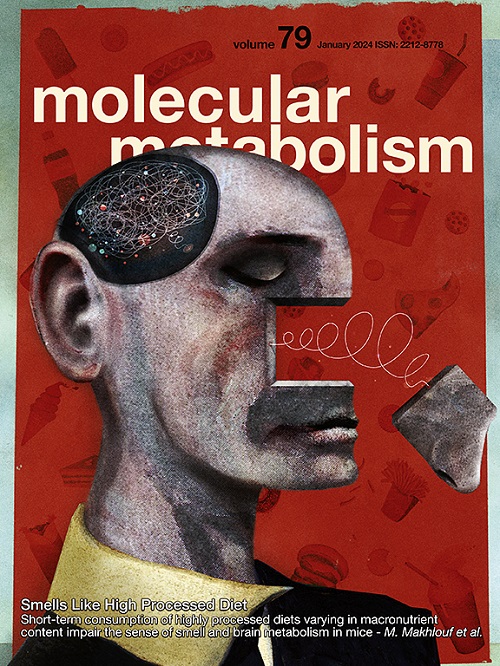RNA binding proteins PCBP1 and PCBP2 regulate pancreatic β cell translation
IF 6.6
2区 医学
Q1 ENDOCRINOLOGY & METABOLISM
引用次数: 0
Abstract
Objectives
Tight control of β cell mRNA translation plays a central role in regulating glucose homoeostasis and β cell health. RNA binding proteins (RBPs) impact translational dynamics and function in networks to achieve their regulatory outcomes, yet an understanding of the RBPs and nature of their interplay in directing β cell translation remain limited. We recently established that the RBP PCBP2 is a key post-transcriptional regulator of β cell function. Here, we investigate the relationship of PCBP2 and its sister-isoform PCBP1 in shaping β cell homeostasis and translation.
Methods
Mice with β cell-specific deletion of Pcbp1 and combined Pcbp1/2 were generated to examine the influence of these factors on blood glucose and β cell homeostasis. Gene expression was interrogated with single-cell RNA sequencing, qRT-PCR, and western blot. RNA-protein interactions were measured using RNA immunoprecipitation. Gene depletion studies were performed using CRISPR-Cas9 or shRNAs. Puromycin labeling was used to monitor global translation.
Results
Pcbp1 deletion preserved glucose homeostasis whereas Pcbp co-deletion resulted in severe diabetes due to compromised β cell viability. Single-cell RNA sequencing of Pcbp co-deficient β cells revealed downregulation of a network of core translation initiation factors and ribosomal mRNAs. Motif enrichment analysis, mRNA-protein interaction, and mRNA stability studies identified that the PCBPs co-impact these mRNAs in part through binding and stabilization. Accordingly, protein translational monitoring demonstrated a requirement for the PCBPs in sustaining global mRNA translation in β cells.
Conclusions
Our findings demonstrate a requirement for the PCBPs in sustaining the global rates of mRNA translation critical for β cell control of glucose homeostasis.
RNA结合蛋白PCBP1和PCBP2调节胰腺β细胞的翻译。
目的:严格控制β细胞mRNA翻译在调节葡萄糖稳态和β细胞健康中起着核心作用。RNA结合蛋白(rbp)影响翻译动力学和网络功能以实现其调节结果,但对rbp及其在指导β细胞翻译中的相互作用性质的理解仍然有限。我们最近发现RBP PCBP2是β细胞功能的关键转录后调节因子。在这里,我们研究了PCBP2及其姊妹异构体PCBP1在形成β细胞稳态和翻译中的关系。方法:制备β细胞特异性缺失Pcbp1和合并Pcbp1/2的小鼠,检测这些因素对血糖和β细胞稳态的影响。通过单细胞RNA测序、qRT-PCR和western blot检测基因表达。采用RNA免疫沉淀法测定RNA-蛋白相互作用。基因耗尽研究使用CRISPR-Cas9或shrna进行。使用嘌呤霉素标记来监测全局翻译。结果:Pcbp1缺失保留了葡萄糖稳态,而Pcbp共缺失由于β细胞活力受损而导致严重的糖尿病。Pcbp共缺陷β细胞的单细胞RNA测序显示核心翻译起始因子和核糖体mrna网络下调。基序富集分析、mRNA-蛋白相互作用和mRNA稳定性研究表明,pcbp通过结合和稳定在一定程度上共同影响这些mRNA。因此,蛋白质翻译监测表明,在β细胞中,pcbp需要维持全局mRNA翻译。结论:我们的研究结果表明,pcbp需要维持mRNA的全球翻译率,这对β细胞控制葡萄糖稳态至关重要。
本文章由计算机程序翻译,如有差异,请以英文原文为准。
求助全文
约1分钟内获得全文
求助全文
来源期刊

Molecular Metabolism
ENDOCRINOLOGY & METABOLISM-
CiteScore
14.50
自引率
2.50%
发文量
219
审稿时长
43 days
期刊介绍:
Molecular Metabolism is a leading journal dedicated to sharing groundbreaking discoveries in the field of energy homeostasis and the underlying factors of metabolic disorders. These disorders include obesity, diabetes, cardiovascular disease, and cancer. Our journal focuses on publishing research driven by hypotheses and conducted to the highest standards, aiming to provide a mechanistic understanding of energy homeostasis-related behavior, physiology, and dysfunction.
We promote interdisciplinary science, covering a broad range of approaches from molecules to humans throughout the lifespan. Our goal is to contribute to transformative research in metabolism, which has the potential to revolutionize the field. By enabling progress in the prognosis, prevention, and ultimately the cure of metabolic disorders and their long-term complications, our journal seeks to better the future of health and well-being.
 求助内容:
求助内容: 应助结果提醒方式:
应助结果提醒方式:


